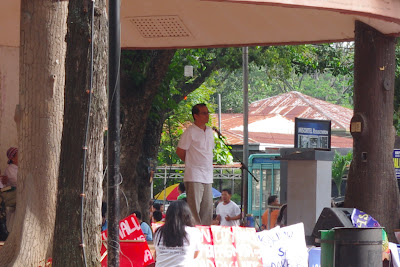Since it annexed the
Philippines in 1898 as an unincorporated
territory, the
United States observed and acknowledged the fervent aspiration
of the
Filipinos to have a free and independent nation. To this end, the
American congress enacted in 1932 the
Hares-Hawes-Cuttings Act setting specific
date of Philippine independence. US President
Herbert Hoover vetoed the bill.
The congress however overrode the president’s veto and the bill became an act.
However, during that time a law pertaining to an unincorporated US territory
had to first get the approval of the legislative body such as the senate in the
case of the Philippines to become enforceable.
Philippine Senate President Manuel
L. Quezon opposed the act because of its objectionable provisions such as the imposition
of tariffs and quota on
Philippine exports to the US and the reservation for American
military bases in the Philippines.
Another law was crafted in the US to change the
Hares-Hawes-Cuttings act. It was called the
Tydings-McDuffie Act of 1934. Little
changes to the provisions of the Hares-Hawes-Cuttings act made the
Tydings-McDuffie Act acceptable to the Philippine senate. It was then signed by the US president and
became a law, and the prospect for an independent Philippines became a
reality.
The Tydings-McDuffie Act gave the Philippines a 10-year
transition period before independence. And until then the Philippines was a commonwealth.
Executive powers would be handed over by the American governor-general to the
new Philippine president. Taking the place of the governor-general was the High
Commissioner of the US to the Philippines who was adviser to the Philippine
President on matters involving the two countries. In the interim period, the
Philippines would have two elected resident commissioners to the US to act as
non-voting Philippine representatives to the US congress.
A constitutional convention in 1934 was called in
Manila.
The convention approved a new constitution on February 8, 1935, and was signed
by US President
Franklin Roosevelt on March 23, 1935. The constitution was ratified
by a popular vote on May 14, 1935. The first
Philippine Presidential Election was
held on September 17, 1935. Manuel L. Quezon was elected as the first president
for a one six-year term. Winning the
vice presidency was Sergio Osmeña. At
first the type of legislature under the constitution was unicameral, but it was
later amended into a bicameral legislature. Foreign affairs and military matters
were the responsibility of the United States and some legislation required the
approval of the US president. In his presidency, Quezon’s advisers included General
Douglas MacArthur who was a US High Commissioner. The latter had a rank of
field marshal of the Philippines.
The attack of the Japanese of the American naval base in
Pearl Harbor, Hawaii on December 7, 1941 precipitated the entry of the United
States into
WW II. Japanese planes bombed
Central Luzon in the Philippines on December
8, 1941. With the advance of the
Japanese forces to Manila, General MacArthur declared it as an "open city" to spare it from destruction that might result in battles.
American and Filipino forces surrendered to the Japanese in May 1942.
The progress made by the Japanese forces in the war, made
Quezon and some of his top government officials move his seat of government to
Corregidor. Later, Quezon with his top government officials joined Macarthur in
del Monte, Bukidnon and from there they flew to Australia. Quezon proceeded to the
United States where he set up his government-in- exile. On August 1, 1944, Quezon died of
tuberculosis
at
Saranac Lake, New York. Sergio Osmeña took his place as the commonwealth
president in exile.
In the absence of the legitimate Philippine government, the
Japanese occupation forces set up a government called the Second Republic of
the Philippines with
Jose P. Laurel as the appointed President. This government
turned out to be unpopular because the Filipinos hated the Japanese occupation
forces.
In 1943, the tide of battle changed in favor of the
Americans and the allied forces in the
Asia-Pacific theater of war. The
Japanese forces suffered huge losses in terms of personnel and equipment and
they were pushed every which way by the advancing allied forces. General
Douglas MacArthur along with President Sergio Osmeña returned to the
Philippines and arrived in
Leyte on October 20, 1944.
The dropping of atomic bombs in the twin Japanese cities of
Hiroshima and Nagasaki on
August 6 and 9, 1945 respectively made Japan surrender unconditionally to the allied forces led by the Americans on
August 14,1945. That act formally ended the war in Asia and the Pacific.
With the end of the war, the commonwealth government was
restored, and a presidential election was held. The incumbent president Osmeña
was the candidate of the
Nacionalista Party. His opponent was
Manuel Roxas of
the
Liberal Party. Osmeña refused to campaign believing that his 40 years of
dedicated and honorable services to the country were enough to bring him to
victory. In contrast, Roxas made a vigorous campaign for the presidency which eventually
rewarded him of winning the election in 1946.
 |
| Pres. Manuel Roxas |
Despite the interruption of the war, the Philippines would
meet its timetable for independence. The historic and memorable day came on
July 4, 1946. The commonwealth had ended and a new era of an independent
Philippines began. In the grand ceremony, Manuel Roxas declared the
independence of the country and retook his oath as its president. The event was
attended by top Philippine and American officials including some foreign
dignitaries and was witnessed by about 400,000 spectators. The lowering of the
American flag and the raising of the
Philippine flag was accompanied with the
clangs of church bells and the cheers of crowds. The waving of the Philippine
flag in the air signified the Filipinos’ realized aspiration for independence
and the hope for a better tomorrow.
Related posts:




















